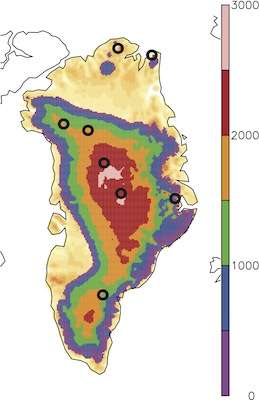Enhanced melting of Northern Greenland in a warm climate

In a new study from the Bjerknes Centre for Climate Research, scientists show how the northern part of the Greenland ice sheet might be very vulnerable to a warming climate.
The study is based on simulations with a state of the art global climate model and a dynamic ice sheet model of the last interglacial warm period. This period (~126 thousand years before present) is the most recent in Earth's history with temperatures warmer than present in the Arctic region, and has frequently been used as an analogue for a future greenhouse climate. During this period we know that the Greenland ice sheet was significantly reduced in size compared to today.
The model simulations show an extreme retreat of the northern part of the Greenland ice cap in response to the warm interglacial climate, a climate not unlike what we expect on Greenland in the very near future. This result is surprising, as temperatures on the north part of Greenland are colder than in the south. However, increased precipitation compensates for much of the increased melting of the southern part of the ice sheet in a warmer climate.
Today, most scientists expect that the southern part of the Greenland ice sheet is most vulnerable to a changing climate. In particular, there are several studies monitoring ice streams and fjord temperatures along the coast of southern Greenland. However, the new results indicate that the northern part of Greenland, at the fringe of the Arctic Ocean, should be particularly closely. In this area part of the ice sheet is grounded below sea level, and can respond rapidly once it starts receding.
If the Greenland ice sheet were to melt completely, it would result in an increase in mean global sea level by about 7 meters. However, the sea level impact of the observed recent accelerated melt of the ice sheet, as well as future projections of melt from the ice sheet, are not implemented by the current generation of climate models included in the IPCC effort.
The study by Andreas Born at the University of Bern and Kerim Nisancioglu at the Bjerknes Centre and University of Bergen was published this Monday in the EGU journal The Cryosphere.
More information: Born, A. and Nisancioglu, K. H.: Melting of Northern Greenland during the last interglaciation, The Cryosphere, 6, 1239-1250, doi:10.5194/tc-6-1239-2012, 2012. www.the-cryosphere.net/6/1239/2012/
Provided by Bjerknes Centre for Climate Research


















